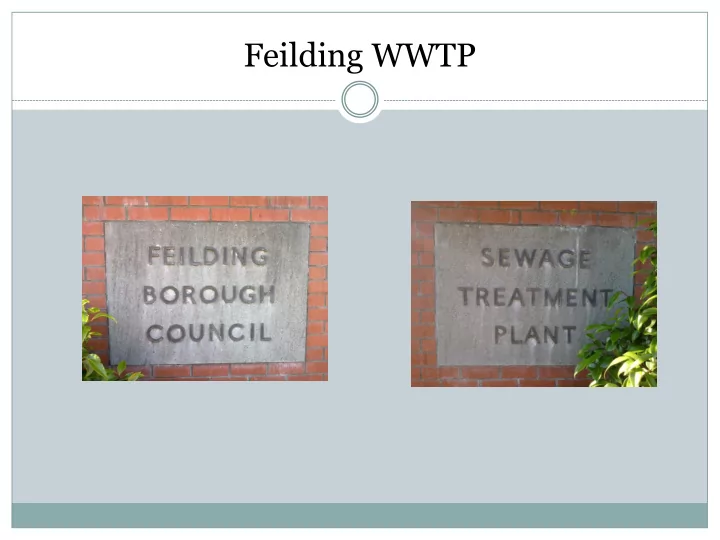

Feilding WWTP
BACKGROUND Located Kawakawa Road Was build in 1967 Prior to plant’s construction, sewage was treated by means of a large septic tank
Feilding WWTP Existing Infrastructure
WWTP Is currently servicing a Also supports a number of population of around industries including: 15,530. Feilding Livestock Based on “ Feilding Saleyards Urban” population of Ovation 14,720 Farmers Transport Ltd Plus Bunnythorpe of 810 Feilding Skin Processors Venison Packers Ltd Manawatu Transport Ltd
Parameter of the Sewage Q = 7,500 m 3 /d TN = BOD 5 = 533 3,285 kg/d kg/d TSS = COD = 9,578 9,765 kg/d kg/d
The Feilding WWTP incorporates the following Unit Processes Coupled Aerated lagoons 1. 2. Primary and Secondary sedimentation/clarification Aerobic Fixed-Growth reactors, commonly known 3. as: Biological Trickling Filters 4. UV disinfection
The removal of carbonaceous The basic organic matter dynamics Nitrification (oxidation of ammonia of these (NH 4 + ) to nitrate (NO 3 ) through unit nitrite (NO 2 ) as intermediate product processes are for: Some denitrification ( The nitrate (NO 3 ) produced is reduced to elementary nitrogen (N 2 gas) which evaporates into atmosphere)
Background to the consent In 2001 a new consent to However, to be allowed permit discharge to the to continue to discharge Oroua River had to be to the river, a new obtained, but was not consent needed to be issued until 25 obtained by August 2009 September 2005 Four consent applications were notified in April 2009 In the interim period the plant is operating under the “old” consent (2005)
MDC received several notifications from Horizons that served as warnings of non- compliance with the 2005 consent Exceeding Ammoniacal Exceeding Nitrogen SS limits limits Diffusion of Exceeding discharge at E.coli limits the river inadequate
Considerably reduce the Discharge of DRP treated waste water to the INTO THE Considerably DISCHARGE reduce TN Oroua River Continued discharge of treated effluent to Significantly the river will reduce the Slightly reduce SIN require upgrading E-coli concentration the existing treatment facility Significantly to enable it to: reduce SS
Issues found through process investigation The treatment process has significant nonlinearities and significant load/flow variations There are a wide range of hydraulic and biological response times Too few manipulated variables and too little control authority
These issues simultaneously affect: The microorganisms’ behaviour and population distributions Disturbing the nitrification/denitrification processes The biomass/effluent separation process becomes easily disturbed Disturbing settling
DISTURBANCES PREVENTION OF SUCH DISTURBANCES MUST BE THE MAJOR GOAL
The mechanism to overcome significant load variations is the implementation of an anaerobic lagoon THE ANAEROBIC LAGOON WILL PROVIDE A BUFFER AND PRELIMINARY TREATMENT FOR SLUGS OF STRONG ORGANIC WASTES
Total influent of Anaerobic Lagoon (future growth) PE 120,000 Q = 10,000 m 3 /d TN BOD 5 =1,033 =7,710 kg/d kg/d TSS COD = =12,153 18,615 kg/d kg/d
The mechanism to improve BOD 5 removal and nitrification/denitrification in the aerated lagoons OPTIONS/STRATEGIES: 1)BIOLOGICAL SUSPENDED GROWTH PROCESS – ACTIVATED SLUDGE PLANT (STEADY STATE PROCESS) 2)INCORPORATION OF FIXED FILM MEDIA COMBINED WITH FLOATING FINE BUBBLE AERATION WITHIN EXISTING LAGOON SYSTEMS
For a more detailed explanation, please see the poster displayed in the lunchroom
The mechanism to improve SS and DRP removal FROM THE PERSPECTIVE OF A VALUE ENGINEERING REVIEW, A PROPRIETARY TERTIARY PHOSPHORUS AND SUSPENDED SOLIDS REMOVAL SYSTEM IN THE FORM OF AN ACTIFLO PROCESS HAS BEEN IMPLEMENTED. IN GENERAL THIS PROCESS REPLACES THE SECONDARY CLARIFIER.
After secondary settling in the Actiflo system the little phosphorous that is left is primarily bound to small particles that do not settle to the bottom of this basin EFFLUENT CONTAINING PHOSPHORUS SHOULD NOT BE DISCHARGED TO THE RIVER WITHOUT FURTHER EFFLUENT POLISHING
Testing has found that the one on the right definitely tastes better
Recommend
More recommend